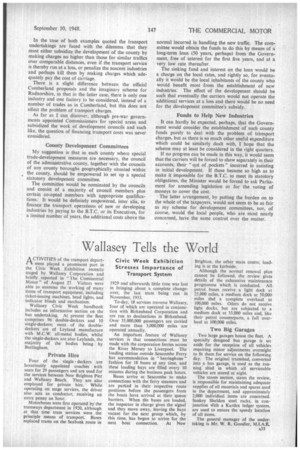Wallasey Tells the World
Page 51

If you've noticed an error in this article please click here to report it so we can fix it.
Civic Week Exhibition Stresses Importance of Transport System
ACTIVITIES of the transport department played a prominent part in the Civic Week Exhibition recently staged by Wallasey Corporation and briefly reported in "The Commercial Motor" of August 27. Visitors were able to examine the working of many items of transport equipment, including ticket-issuing machines, head lights, and indicator blinds and mechanism.
Wallasey Civic Week handbook includes an informative section on the bus undertaking. At present the fleet comprises 96 double-deckers and 10 single-deckers; most of the doubledeckers are of Leyland manufacture with M.C.W. all-metal bodies, whilst the single-deckers are also Leylands, the majority of the bodies being by Burlingham.
Private Hire
Four of the single deckers are luxuriously appointed coaches with seats for 29 passengers and are used for the services between New Brighton Pier and Wallasey Beach. They are also employed for private hire. While operating on stage services, the driver also acts as conductor, receiving an extra penny an hour.
Motorbuses were first operated by the tramways department in 1920, although at that time tram services were the principle means of transport, Buses replaced trams on the Seabank route in
1929 and afterwards little time was lost in bringing about a complete changeover, the last tram being run in November, 1933.
To-day, 18 services traverse Wallasey, four of which are operated in conjunction with Birkenhead Corporation and are run to destinations in Birkenhead. Over 35,000,000 passengers are carried and more than 3,000,000 miles are operated annually.
An important feature of Wallasey services is that connections must be made with the corporation ferries across the River Mersey to Liverpool. The loading station outside Seacombe Ferry has accommodation in "herringbone" fashion for 18 buses at any time, and these loading bays are filled every 10 minutes during the business peak hours.
Buses arrive at Seacombe to make connections with the ferry steamers and are parked in their respective route positions before the passengers from the boats have arrived at their queue barriers. When the buses are loaded, the inspector in charge gives the signal and they move away, leaving the bays vacant for the next group which, by this time, has begun to arrive for the next boat connection. At New Brighton. the other main centre, loading is at the kerbside.
Although the normal renewal plan cannot be followed, the review gives details of the exhaustive maintenance programme which is conducted. All petrol buses ,receive a light dock at 25,000 miles, a medium dock at 50,000 miles alid a complete overhaul at 100,000 miles. Oilers do not receive light docks, but are subjected to a medium dock at 33,000 miles and, like their petrol counterparts, a full overhaul at 100,000 miles.
Two Big Garages Two large garages house the fleet. A specially designed bus garage is set aside for the reception of all vehicles requiring minor adjustments overnight to fit them for service on the following day. The original tramshed, converted into a bus garage, is used as the runningstied in which all serviceable vehicles are stored at night.
The stores section, states the review, is responsible for maintaining adequate supplies of all materials and spares used in the department, and approximately 2,000 individual items are concerned. Sankey Sheldon steel racks, in conjunction With a Kardex ledger system, are used to ensure the speedy location of all items.
The general manager of the undertaking is Mr. W. R. Goodier, M.I.A.E. A33




















































































